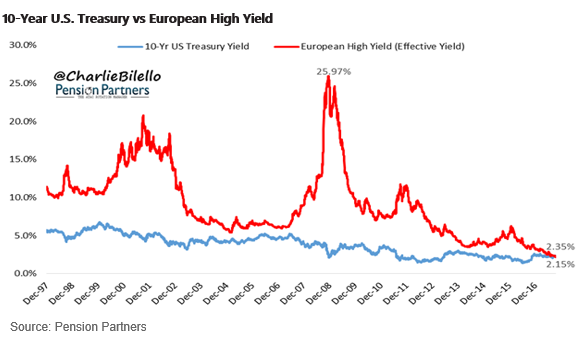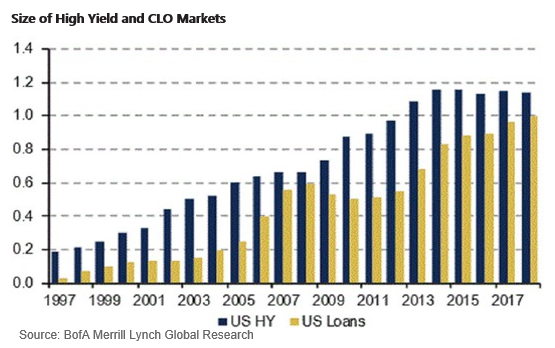This site uses cookies. By continuing to browse the site, you are agreeing to our use of cookies. Privacy Policy
Okay, thanksIn previous posts, I’ve discussed the risks in treasuries and corporate bonds in this current economic environment. But what is the outlook for non-investment grade, or “junk” bonds? What about the massive growth in the collateralized loan obligation (CLO) market?
Investors in this space have always emphasized higher levels of income or growth rather than capital preservation. These investments are often termed “speculative,” which would suggest buyers are cognizant of the risks of the asset class, but are they truly aware of the amount of risk in these asset classes?
The massive issuance of leveraged loan products and the looser lending standards have increased the risk of high yield bonds and collateralized loan obligations. As investors seek to fulfill their income needs, they may be taking on more risk than they can handle.
The emphasis has clearly been on yield rather than capital preservation in the post-GFC world.
The chart below shows how much downward pressure has been placed upon European high yield bonds. According to this chart, credit risk, default risk, and currency risk are currently only worth 20 basis points more than Treasuries.

The high yield bond market has followed an interesting path in the aftermath of the GFC. Initially high yield bonds rebounded well, and the size of the market doubled. However, over the last five years the size of the high yield market has plateaued. Instead, leveraged loans and CLOs have become the preferred debt of choice for non-investment grade borrowers and lenders.
Borrowers who would have previously been issuers of high yield bonds have either been “pushed up” into the BBB range, as discussed previously, or “pulled out” by the attractiveness of the leveraged loan market.

Driving the growth in the leveraged loan space has been the loosening of lending standards in the leveraged loan market.
According to the S&P/LSTA Loan index, over 75% of recent leverage loan issues are classified as “covenant lite.” In a “cov-lite” situation, borrowers have much more leeway in maintaining specified financial targets.
Obviously, it is in the best interest of individual borrowers to negotiate the least restrictive loan terms possible. But when so much issuance is done on such liberal terms it suggests too much money is chasing too few deals. In 2007, when the leveraged loan market was less than half the size it is now, only 17% of issuance was covenant lite1.
Why have lenders been so eager to lend, and lend without covenants? This ties back to the initial problem about the lack of yield from traditional sources like Treasuries or investment grade bonds.
Lenders have been so thirsty for income they have been getting progressively more lenient on lending standards, giving borrowers the “green light” to take on more risk. While an economic downturn has yet to test these borderline issuers, a trade-off has been made between increased income potential and downside risk.
Some market watchers are raising warning flags about the number of similarities between the CLO market and the pre-GFC mortgage backed security (MBS) market.
At an industry conference on May 20, 2019 Federal Reserve Chairman Jerome Powell spoke about the threat posed by the $1.2trn CLO market to the overall financial system. Mr. Powell claims the financial system is in a much better position to handle any turmoil and that the Fed does not view CLOs as a systemic threat. Mr. Powell stated, “We take the risks from business debt seriously but think that the financial system appears strong enough to handle potential losses.”2 Whether one should be relieved or alarmed by Powell’s sanguine outlook is open for debate.
Whether it’s treasury bonds, corporate bonds, or high yield bonds/CLOs, it seems highly unlikely that bonds can play the dual role of income and capital preservation in portfolios going forward. If rates stay low and monetary policy remains loose, then bond holders are stuck with a measly yield barely enough to cover inflation. If rates start increasing, the prices of existing bonds will fall. Neither of these scenarios will provide bonds with the 7.69% rate of return enjoyed over the last three and half decades.
It is the opinion of Swan Global Investments that the long bull market in bonds that started in the early 1980s is drawing to a close, so investors must look beyond bonds for capital preservation.
Capital preservation and offsetting volatility in equity markets is of paramount importance when it comes to long-term investment success. At Swan Global Investments, we believe that over the long term, buy-and-hold equity investments need downside protection.
Rather than relying on bonds to perform this pivotal role, a hedged equity approach, which hedges market risk via put options, is an attractive alternative for seeking a combination of growth with some capital preservation within a portfolio. Given the pessimistic outlook for bonds, we believe a hedged equity strategy is a much more effective way of countering downside risk, without the credit, liquidity, duration or other risks associated with bonds, especially high yield and CLOs. Read why here.
Marc Odo, CFA®, CAIA®, CIPM®, CFP®, Client Portfolio Manager, is responsible for helping clients and prospects gain a detailed understanding of Swan’s Defined Risk Strategy, including how it fits into an overall investment strategy. Formerly, Marc was the Director of Research at Zephyr Associates for 11 years.
1 “Opinion: The Next Wreck in Junk Bonds Will Be Bigger, Longer, and Uglier.” Jonathan Rochford, MarketWatch; June 16, 2018.
2 “Powell Says Leveraged Lending Isn’t Posing a Crash Threat.” Jesse Hamilton, Bloomberg. May 20, 2019
Swan Global Investments, LLC is a SEC registered Investment Advisor that specializes in managing money using the proprietary Defined Risk Strategy (“DRS”). SEC registration does not denote any special training or qualification conferred by the SEC. Swan offers and manages the DRS for investors including individuals, institutions and other investment advisor firms. Any historical numbers, awards and recognitions presented are based on the performance of a (GIPS®) composite, Swan’s DRS Select Composite, which includes non-qualified discretionary accounts invested in since inception, July 1997, and are net of fees and expenses. Swan claims compliance with the Global Investment Performance Standards (GIPS®).
All Swan products utilize the Defined Risk Strategy (“DRS”), but may vary by asset class, regulatory offering type, etc. Accordingly, all Swan DRS product offerings will have different performance results due to offering differences and comparing results among the Swan products and composites may be of limited use. All data used herein; including the statistical information, verification and performance reports are available upon request. The S&P 500 Index is a market cap weighted index of 500 widely held stocks often used as a proxy for the overall U.S. equity market. Indexes are unmanaged and have no fees or expenses. An investment cannot be made directly in an index. Swan’s investments may consist of securities which vary significantly from those in the benchmark indexes listed above and performance calculation methods may not be entirely comparable. Accordingly, comparing results shown to those of such indexes may be of limited use. The adviser’s dependence on its DRS process and judgments about the attractiveness, value and potential appreciation of particular ETFs and options in which the adviser invests or writes may prove to be incorrect and may not produce the desired results. There is no guarantee any investment or the DRS will meet its objectives. All investments involve the risk of potential investment losses as well as the potential for investment gains. Prior performance is not a guarantee of future results and there can be no assurance, and investors should not assume, that future performance will be comparable to past performance. All investment strategies have the potential for profit or loss. Further information is available upon request by contacting the company directly at 970-382-8901 or www.swanglobalinvestments.com. 440-SGI-111319